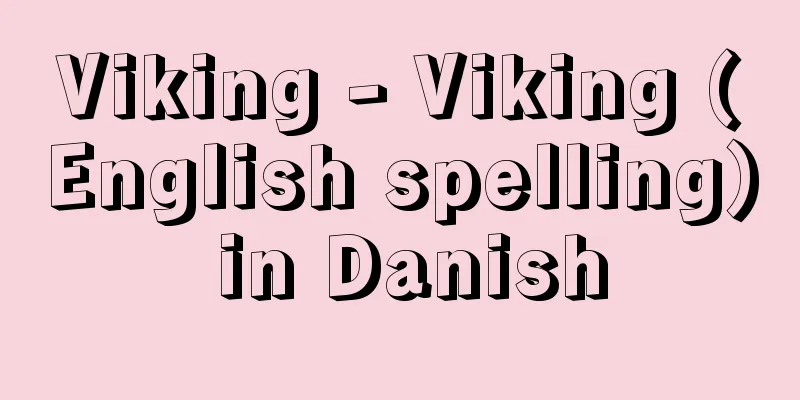Viking - Viking (English spelling) in Danish

|
Another name for the North Germanic people (Normans) who invaded various parts of Europe by sea from the end of the 8th century to the latter half of the 11th century. "Viking" is commonly used in English, but "Viking" is the correct term. They are broadly divided into Danish, Norwegian, and Swedish. This migration of people is also called the second migration of people, along with the Magyars and Muslim Arabs who invaded Europe at the same time. There are various theories about the origin of the word Viking, including the Anglo-Saxon word wicing (warrior), inhabitants of vik (inlet), which are common in Northern Europe, and visitors to vicus (a place where goods are gathered), but there is no consensus. Generally, the reasons for the Vikings' activities are thought to be land shortages due to population growth, the existence of chiefs who sought new lands overseas, and warming of the climate, which was suitable for expeditions. However, the prerequisite is the development of fast warships equipped with sails that could navigate both rivers and oceans. This allowed them to cross oceans and travel deep inland from the coasts along major rivers, achieving considerable success with their swift surprise attacks. Their activities were not limited to plunder, but also diversified to include conquest, colonization, trade, and mercenary activities. In the early stages, they would go on "working away" expeditions in the summer to obtain loot, attacking defenseless churches and monasteries and returning to their homeland before winter, but gradually they began to spend the winter at river mouths and coasts in foreign lands, and from there they organized themselves and settled down through repeated invasions. At the same time, the internal division of Europe at the time made invasions easier, and some princes responded to the Viking invasions with Viking mercenaries, spurring further colonisation that culminated in the founding of Dane law in England, the Duchy of Normandy in France and the Principality of Novgorod in Russia. Overall, these foreign activities were an important catalyst for the establishment of feudal society in Western Europe, and this period was a time of political unification of the Nordic countries. Furthermore, plundering, colonization, and trading activities in various parts of Europe developed major trading centers such as Hesby in Denmark, Birka in Sweden, and Kaupang in Norway, promoting long-distance trade, and Christian missionary activities along these trade routes gradually incorporated Scandinavia from a pagan society that worshipped the gods Odin and Thor into the Christian world of Europe. Below is an overview of the activities of the Danish, Norwegian, and Swedish groups. [Akihisa Arakawa] DanishThe first expeditions from Denmark were made in the early 9th century, when the Dane King Godfred attacked Frisia, as his southern border was threatened by the subjugation of the Saxons by the Frankish Emperor Charlemagne. Successive kings fought back by strengthening coastal defenses and building fleets, but this was ineffective, and by the middle of the century, commercial centres such as Dorestad, Kantovic and Hamburg had been plundered and destroyed. Troops that had already been colonised in the north-east of England joined the expedition, and it looked as if they would reach the Meuse River basin and Trier inland, but they were defeated by King Arnulf at Louvain and fled in rout (891). Meanwhile, a group of people who had begun to settle in Normandy after 820 went up the Seine and relentlessly besieged and occupied Paris (845-889), which resulted in Charles III the Simple making his chieftain Rollo Duke of Normandy in the Treaty of Saint-Clair-sur-Epte (911) on the condition that he convert. Here, they quickly became French, and their invasions ceased. The northeast of England was attacked from around 835, and by the middle of the same century widespread colonization had progressed, leading to attacks on the continent. Alfred the Great of Wessex prevented them from moving south, and recognised the Dane Law region in a treaty (886), but after his death the region was once again under the rule of the Wessex royal family. A period of peace continued from 925 to 980, but this was likely due to the situation within Scandinavia, including the unification project (around 960) of Harald (Blue Tooth), whose name is inscribed on the Great Jelling Stone as "having acquired all of Denmark and Norway and converted the Danes to Christianity." At the end of the 10th century, Olaf I of Norway and Harald's son Sweyn (King Sweyn the Bearded) threatened England and collected a large amount of Danish tax (994), and Sweyn's son Cnud (the Great) became king of Denmark, Norway and England, establishing the Christian "North Sea Empire" (1017-35). After William I, Duke of Normandy, conquered England in 1066, invasions ceased and a Norman feudal state was formed. [Akihisa Arakawa] NorwegianAt the end of the 8th century, the Norwegians used the Shetland and Orkney Islands as bases to watch the coasts of Scotland and Ireland. In the early 9th century, they colonized the Isle of Man and began their invasion of Ireland. In 837, Turgeis (date of birth and death unknown) built the fortress city of Dublin and proclaimed himself King of Ireland. The kings of the Kingdom of Dublin, founded by Olaf the White (853), later fought with the Danes in the north of England and attempted to unite Ireland, but were defeated by the native king Brian Boru (1014) and fell into decline. However, the bases they built in Ireland later developed into trading centres. Around this time, after large-scale expeditions by Olaf I and Olaf II of Norway, Harald III (the Strong) attempted to conquer England, but was killed in battle at Stamford Bridge (1066), marking the last major offensive by England. In the Frankish Kingdom, Rouen was burned in 843, and the following year the Westfaldingi (inhabitants of Vestfold in the Oslo Fjord) plundered Nantes at the mouth of the Loire River and engaged in trade on the island of Noirmoutier, where salt and wine were accumulated. Some of them bypassed the Iberian Peninsula and made contact with Muslim powers in the Mediterranean. In the North Atlantic, Iceland was discovered around 860, based in the Faroe Islands, and colonization was completed and an Althing (Diet) was established by around 930. The Icelander Erik (the Red) traveled to Greenland and colonized it (around 982), and his son Leif (the Lucky) explored the northeast coast of America around 1000, but did not colonize it. [Akihisa Arakawa] Swedish descentThe people who moved eastward were mainly of Swedish descent, and many runic inscriptions found in Sweden commemorate their compatriots who "died in the East", including references to Greece and Serkland (a region east of the Caspian Sea). They advanced to the eastern shore of the Baltic Sea from the 7th century, and in the 9th century they settled around Lake Ladoga in northern Russia, and mainly had trade relations with the Byzantine Empire via the Dnieper River and the Black Sea, and with Islamic countries along the Volga River across the Caspian Sea. The Beltane Chronicle records the Swedes passing through Russia in 839 and accompanying a Byzantine envoy to visit Louis the Pious. According to the Primary Chronicle, compiled in Kiev around 1112, in 862, Rurik, the chief of Rus (a Finnic dialect for Swedes), was invited by the Slavs to establish the Principality of Novgorod, and his subordinate Oleg moved the capital there in 882 and established the Principality of Kievan Rus in the middle reaches of the Dnieper River. In the 10th century, the Rus' invaded the Byzantine capital of Constantinople and obtained various commercial privileges within the empire. A comparison of the Rus' names signed in the commercial treaties concluded between the two countries in 912 and 945 reveals the rapid process of their Slavicization. However, the ties of kinship between the Kievan princes and Nordic kings such as Olaf I and Olaf II continued to be maintained. During this period, the Nordic people who gained fame as mercenaries or imperial guards in Kievan and Constantinople were called Varangians, and Harar III of Norway is a famous example. Through them, Greek Orthodox Christianity and Byzantine culture were introduced to Russia and Northern Europe. On the other hand, some people traveled from Novgorod to the large city of Bulgaria in the middle reaches of the Volga River around the 9th century, and then traveled down to the Caspian Sea and maintained trade relations with the Arabs. These people brought large amounts of Arab silver coins into northern Russia and Sweden from the 9th to the mid-10th centuries, and the Arabs called them Rus' merchants. [Akihisa Arakawa] "The World of the Vikings" by Jacqueline Simpson, translated by Katsumi Hayano (1982, Tokyo Shoseki) " "The Vikings of the North: A Society of Strength and Friendship" by Satoshi Kumano (1983, Heibonsha) The church and tomb in Jelling, the birthplace of the Kingdom of Denmark. The photo shows the mound said to be the tomb of King Gorm the Elder, father of King Harar, and his wife. World Heritage Site "Jelling Tomb, Runic Stones and Church" (Denmark, registered in 1994) Near Vejle, Denmark ©Shogakukan "> Jelling Tomb Longships used by the Vikings. Around 1000. ©Shogakukan Library "> Viking ship Source: Shogakukan Encyclopedia Nipponica About Encyclopedia Nipponica Information | Legend |
|
8世紀末より11世紀後半にかけて海上からヨーロッパ各地に侵入した北ゲルマン人(ノルマン人)の別称。「バイキング」は英語読みで慣用的に用いられるが、「ビーキング」の呼び方が正しい。デンマーク系、ノルウェー系、スウェーデン系に大別される。この民族の移動は、同じころヨーロッパに侵攻したマジャール人やイスラム教徒アラブ人とともに、第二の民族移動ともよばれる。バイキングの語源に関しては、アングロ・サクソン語のwicing(戦士)、北欧に多いvik(入り江)の住人、vicus(商品集積地)を訪れる者などの諸説があるが、定説はない。 一般にバイキングの活動の原因には、人口増加による土地不足、海外に新天地を求めた首長の存在、遠征に適した気候の温暖化などが考えられるが、帆を装備して河川航行、大洋航海とも可能な快速軍船の開発がなされたことが前提であろう。これにより、大洋を越え、沿岸部から主要河川を内陸深く遡行(そこう)し、敏速な奇襲戦法でかなりの成功を収めたからである。その活動は、略奪行為にとどまらず、征服、植民、交易、傭兵(ようへい)と多様に変化した。初期の段階では、戦利品獲得を目的とした夏期の「出稼ぎ」的遠征で、無防備な教会・修道院を襲撃しては冬期以前に故地へ戻っていたが、徐々に異国の河口・沿岸部で越冬を始め、ここから侵入を繰り返しつつ組織化し、定住していった。同時に、当時のヨーロッパ内部の分裂状態は侵入を容易にし、また王侯のなかにはバイキングの侵攻にバイキング傭兵で対処した者もおり、彼らの植民に拍車がかけられて、イングランドのデーン・ローDane law地方(デーン人の法慣習施行地域)、フランスのノルマンディー公国、ロシアのノブゴロド公国などの建設をみるに至った。 総じてこれらの対外活動は、西欧封建社会成立の重要な契機となり、またこの時代は北欧諸国の政治的統一期であった。さらにヨーロッパ各地での略奪、植民、交易活動は、デンマークのヘズビュー、スウェーデンのビルカ、ノルウェーのカウーパンなどの主要交易地を発展させ、遠隔地交易を促進し、またこの交易路に沿ったキリスト教伝道活動により、北欧はオーディンやトールの神々を信奉する異教社会から、しだいにヨーロッパ・キリスト教世界へと編入されていくのである。以下に、デンマーク系、ノルウェー系、スウェーデン系のそれぞれの活動を概観する。 [荒川明久] デンマーク系デンマークからの遠征は、9世紀初頭、フランク王国カール大帝のザクセン人平定により国境南部を脅かされたデーン人ゴズフレズ王が、フリースラントを攻撃したことに始まる。大帝以後の諸王は、沿岸防備強化と艦隊建造でこれに対抗したが効果は薄く、同世紀中ごろまでに商業地ドレスタットやカントビック、ハンブルクなどが略奪、破壊された。当時すでにイングランド北東部に植民していた部隊も加わり、マース川流域や内陸のトリールに達する勢いであったが、ルーバンでアルヌルフ王に撃破され、敗走した(891)。一方、820年以降ノルマンディー地方に定住し始めた一団はセーヌ川をさかのぼり、執拗(しつよう)にパリを攻囲、占領し(845~889)、その結果シャルル3世(単純王)はサン・クレール・シュル・エプト条約(911)で、改宗を条件に首長ロロをノルマンディー公に封じた。ここでは彼らは急速にフランス化し、以後侵入もやんだ。 イングランド北東部は、835年ごろから襲撃され、同世紀中ごろには広範な植民が進み、ここから大陸攻撃もなされた。ウェセックスのアルフレッド大王は、彼らの南下を阻止し、条約でデーン・ロー地方を承認した(886)が、大王没後この地域はふたたびウェセックス王家の支配に服した。925~980年にかけて平穏な時代が続くが、これは「全デンマークとノルウェーを獲得し、デーン人をキリスト教徒にした」とイェリング大石碑に彫られたハラール(青歯王)の統一事業(960ころ)など、北欧内の情勢に起因しよう。10世紀末になると、ノルウェーのオーラフ1世やハラールの子スベン(双髯(そうぜん)王)は、イングランドを威嚇して多額のデーン税を徴収し(994)、さらにスベンの子クヌード(大王)はデンマーク・ノルウェー・イングランド王となり、キリスト教的「北海帝国」を樹立した(1017~35)。1066年、ノルマンディー公ギヨーム(ウィリアム1世)のイングランド征服以後は侵入もやみ、ここにノルマン朝封建国家が形成された。 [荒川明久] ノルウェー系ノルウェー系は、8世紀末にシェトランド、オークニー両諸島を基地としてスコットランドやアイルランドの沿岸部をうかがった。9世紀初期にはマン島に植民してアイルランド侵攻を開始し、837年にトゥルゲイスTurgeis(生没年不詳)は要塞(ようさい)市ダブリンを建設してアイルランド王を自称した。オーラフ白王の建設した(853)ダブリン王国の諸王は、のちにイングランド北部でデーン人と争い、他方アイルランド統一を試みるが、先住民の王ブライアン・ボルーBrian Boruに撃破され(1014)、衰微した。しかし、彼らがアイルランドに建設した基地は、のちに交易地として発展する。このころイングランドではノルウェーのオーラフ1世、オーラフ2世らの大規模遠征を経て、ハラール3世(強意王)は征服を企てたが、スタンフォード橋で戦死し(1066)、これがイングランド最後の大攻勢となった。 フランク王国では、843年にルーアンが焼かれ、翌年ウェストファルディンギWestfaldingi(オスロ峡湾のベストフォルVestfold地方の住人の意)がロアール河口のナントを略奪し、塩とワインの集積地ノアールムーティエ島で交易に従事した。彼らのなかには、イベリア半島を迂回(うかい)して地中海のイスラム教徒勢力と接触した者もいた。 北大西洋ではフェロー諸島を拠点に860年ごろアイスランドが発見され、930年ごろまでに植民が完了、アルシンク(国会)が設立された。アイスランド人エリック(赤毛の)は、グリーンランドに向かって植民し(982ころ)、息子のレイブ(幸運児)は1000年ごろアメリカ北東岸を探検したが、植民には至らなかった。 [荒川明久] スウェーデン系東方に進出したのはおもにスウェーデン系で、スウェーデンで発見される多数のルーン碑銘は、「東方で没した」同胞を記念したもので、ギリシアやセルクランド(カスピ海の東部地方)に言及するものもある。 彼らは7世紀からバルト海東岸部に進出し、9世紀には北ロシアのラドガ湖周辺に定住して、ドニエプル川と黒海によりビザンティン帝国と、またボルガ川沿いにカスピ海を越えてイスラム教国と、おもに交易関係をもった。『ベルタン年代記』は、839年ロシアを通過し、ビザンティン帝国の使節に随伴してルイ1世(敬虔(けいけん)王)を訪れたスウェーデン人を記録する。1112年ごろにキエフで編纂(へんさん)された『原初年代記』によると、862年ルーシ(スウェーデン人をさすフィン語の訛(なま)り)の首長リューリクは、スラブ人らに招致されノブゴロド公国を、また部下のオレーグは、882年に遷都してドニエプル川中流にキエフ公国を建設した。10世紀に入ると、ルーシ人はビザンティン帝国の首都コンスタンティノープルに遠征し、種々の商業特権を帝国領内で獲得するが、両者間で結ばれた912、945両年の通商条約に署名されたルーシ人名の比較から、彼らの急速なスラブ化の過程が判明する。しかし、キエフ諸公と、オーラフ1世、オーラフ2世ら北欧諸王との親縁関係は、以後も維持された。この時代、キエフやコンスタンティノープルで傭兵あるいは皇帝の親衛隊として勇名をはせた北欧人はワリャーグとよばれ、ノルウェーのハラール3世は著名であるが、彼らを通じてギリシア正教、ビザンツ文化がロシア、北欧にもたらされた。 一方、9世紀ごろにノブゴロドからボルガ川中流の町ブルガルの大市へ赴き、さらにカスピ海へ下ってアラブ人と交易関係を維持した者もあるが、彼らは9~10世紀中ごろまで北ロシアやスウェーデンにアラブ銀貨を多量に流入させ、アラブ人は彼らをルーシ商人とよんでいた。 [荒川明久] 『ジャクリーヌ・シンプソン著、早野勝巳訳『ヴァイキングの世界』(1982・東京書籍)』▽『熊野聰著『北の農民ヴァイキング――実力と友情の社会』(1983・平凡社)』 デンマーク王国発祥の地イェリングにある聖堂と墳墓。写真はハラール王の父ゴーム老王夫妻の墓といわれている墳丘。世界文化遺産「イェリング墳墓群、ルーン文字石碑群と聖堂」(デンマーク・1994年登録) デンマーク バイレ近郊©Shogakukan"> イェリング墳墓 バイキングが用いた長船(ロングシップ)。1000年ごろ©小学館ライブラリー"> バイキング船 出典 小学館 日本大百科全書(ニッポニカ)日本大百科全書(ニッポニカ)について 情報 | 凡例 |
>>: Hiking - Haikingu (English spelling)
Recommend
Calligram
...The collection of essays from this period is C...
Keno
It can also be read as "Keno". In ancien...
Webb, WF - Webb
… [Judgment] The results of the verdict are shown...
Revitalization movement
...Other examples include the cargo cults of Mela...
Foxtrot
〘noun〙 (fox-trot) A type of dance music. A ragtime...
Cardiff Castle - Cardiff Castle
A castle in the center of Cardiff, the capital of ...
Artur Grottger
1837‐67 Polish painter. In Polish, his name is Gro...
Anne Louis Girodet-Trioson
1767‐1824 French Neoclassical painter. Born in Mon...
Skinner - Burrhus Frederic Skinner
A representative contemporary American psychologi...
Kandāriya Mahādeva (English spelling)
…The numerous statues of gods, apsaras (celestial...
Ikuhi Shrine
...There are several theories about the origin of...
Houphouët-Boigny, F.
...Both the president and the members of parliame...
Kanryomai rice
...It refers to the rice and money collected by k...
Nestorianism
Nestorianism was the first Christian sect to be i...
Fuchu Five Mountains
A collective name for five temples of the Myoshinj...









